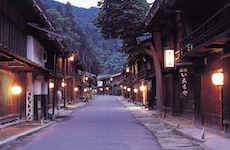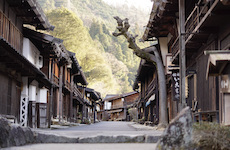*This English text was created by the Japan Tourism Agency
A Perfectly Preserved Post Town Tsumago was officially designated as a post town in 1601 when shogun Tokugawa Ieyasu established the post town system. It was the 42nd of a total of 69 such towns along the roughly 530-kilometer length of the Nakasendo from Edo to Kyoto. Although it was not as heavily traveled as the easier Tokaido route, which ran along the Pacific coast, the Nakasendo played a crucial part in the sankin kotai system, which required the feudal lords to travel from their domains to Edo every second year. In 1868, sovereign rule of the country returned to the emperor, and the shogunate ended. With the construction of a new national road in 1892 and a railway that began service in 1909, Tsumago, deprived of its post town function, went into slow decline. In 1968, efforts to preserve the town got underway. As Japan’s postwar economic miracle was sweeping away much of the old way of life, the traditional townscape of Tsumago touched a chord in the national consciousness. In 1976, Tsumago was officially selected as a preservation zone, encompassing just under 1,250 hectares of the town and the surrounding mountains. Thirty-four percent of all the buildings in Tsumago are historic buildings dating from the Edo period up to the years before World War II. Tsumago pioneered Japan’s conservation movement, and its model has been widely copied around the country. Around 200 buildings in the town had been repaired and restored (as of 2019).



